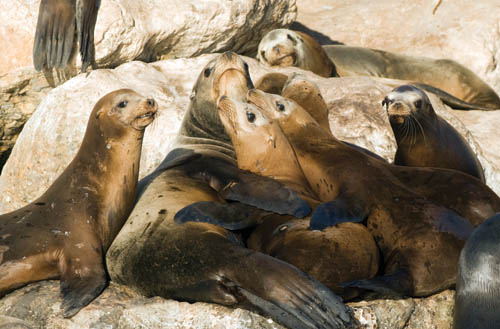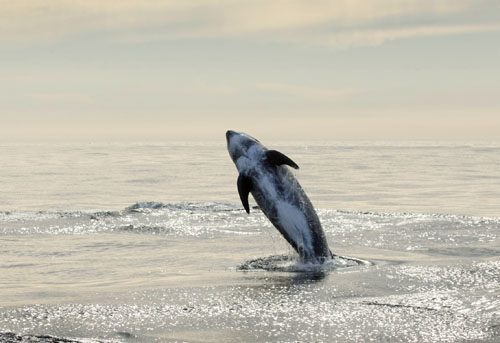Protecting the Songs of the Sea
ByJean-Michel Cousteau

The sea is not a silent world. There are songs in the ocean that must be heard. Some are just whispers, but meaningful ones. Listen to the diverse repertoire of sounds and songs as you dive beneath the surface of the sea. The haunting calls of the blue whales can travel across thousands of miles of ocean. This is only one of many songs of the seas, including passionate arias of humpback whales, the staccato survey of the dolphin and the territorial pounding of the drum fish. It is a world of aquatic operas, where animals must make sense of the sounds to find food and each other, and to avoid danger.
Acoustic Holocaust
But now the ocean is threatened by what has been called an “acoustic holocaust”: the blasting of the sea with sound. In addition to the high-intensity, mid-range sounds that military operations already produce, Navies of the world are now experimenting with Low Frequency Active sonar system (LFA). LFA generates extremely loud sounds to detect silent submarines at great distances. These sounds can flood entire ocean basins. Scientists claim that the noise from a single LFA test off of California coast was detected across the entire North Pacific Basin.
Recent controversy also has been brewing off the central coast of California. Proposed underwater seismic testing on California’s Diablo Canyon Nuclear Power Plant has prompted widespread concern about the issue of global high-energy seismic testing and the implications of increasing noise pollution in the world’s oceans.
The Diablo Canyon Nuclear Power Plant is an electricity-generating nuclear power plant that provides energy to nearly three million California residents. Built in the early 1970s along a geological fault line, the power plant has had a long history of controversy with respect to both environmental impact and residential safety. Numerous new fault lines running both onshore and offshore to the Diablo Canyon power plant have been identified, some as recently as 2008. After the devastating 2011 Fukushima earthquake and subsequent power plant failure, concerns have increased over the safety and necessity of the Diablo Canyon power plant.

Collateral Damage
In an attempt to mitigate concerns, owners of the Diablo Canyon power plant, the Pacific Gas and Electric Company (PG&E), have chosen to mount an extensive seismic testing survey in the hopes of obtaining detailed 3D images of the fault zones near the plant. PG&E plans to submerge underwater air cannons that will detonate blasts of 250 decibels every 10 to 20 seconds in three areas of the Pacific over 33 days. These blasts are equivalent to the detonation of an atomic bomb and will kill or otherwise impact tens of thousands of marine animals, including Pacific Gray Whales. Considering the extent to which the marine world uses sound, particularly the twenty-five species of marine mammals that reside within California’s coastal waters, the air cannon blasts will have detrimental effects to animals within 250 square nautical miles of each of the air cannon sites. Whales, dolphins, porpoises, seals and sea lions that are not killed by the immediate blast will likely suffer slow deaths, as impairment to their extremely sensitive hearing will result in an inability to find food or navigate underwater. I have spent a great deal of time studying and learning about the lives of gray whales with my Ocean Futures Society team. Once hunted to the brink of extinction, these amazing animals have been able to recover, and now thrive within California’s waters. Ocean Futures Society, in co-production with KQED, spent a year filming gray whales for the PBS Special, ‘Gray Whale Obstacle Course’. This special offers insight into the lives of these beautiful animals. However, high energy seismic testing poses a huge risk to these whales, and all others that inhabit our coastal waters.
The desire to produce more energy from oil and gas deposits beneath the sea floor has led large energy corporations to extend their search further into the ocean. As a result, high-energy seismic testing has become increasingly common throughout the ocean, and international concern about the potentially harmful effects on marine life has increased.
Physical Trauma
With the dawn of the industrial age and the subsequent spread of globalization, humans have been filling the oceans with more noise than ever before. The massive increase in the amount of commercial shipping traffic, high-energy seismic testing for underwater oil and gas reserves, as well as the military’s use of Low Frequency Active (LFA) sonar, have impacted and killed thousands of whales and dolphins throughout the world already. Locations as wide spread as the Bahamas, the Canary Islands, and Norway have all seen deaths that have been directly attributed to the use of high-intensity seismic testing or military sonar, as these animals have been found with trauma or brain injuries consistent with high-impact sounds. Numerous studies have also found bubbles in the tissues of beached whales and dolphins following exposure to active sonar testing and scientists suggest that the booming and explosive sounds of high-energy testing may be causing frightened marine mammals to ascend quickly to the surface, making them vulnerable to the harmful effects of decompression sickness and deadly gas bubbles in their bodies.
Sound, which travels five times faster in water than in air, is one of the most vital and valuable sensory abilities used by marine mammals in the ocean. Many rely extensively on sound to hunt, navigate, and otherwise communicate with one another underwater. Sperm whales, for example, utilize their massive bulbous heads to emit low-frequency clicking noises to locate their prey thousands of feet below the surface. The increasing use of naval sonar and other high-energy testing by humans greatly interferes with the whale’s ability to hunt. Examination of the ear bones of dead sperm whales have been shown to contain pits and lesions, which have led scientists to believe that these animals likely suffered chronic decompression sickness during the course of their lives. After being on the brink of extinction from whalers in the 18th century, sperm whales, like the Gray whale and most other whale species, have slowly been making a comeback. The continued use of high-energy testing seriously threatens the future of these magnificent animals.
Instant Devastation
Fisheries around the world have also felt the devastating consequences of high-energy testing in the ocean. After a single air cannon array, fisheries along the Norwegian coast saw a 40{c383baab7bef8067e8c9786a45d8006c492489841a98fe37723e304bb1ddd030} to 80{c383baab7bef8067e8c9786a45d8006c492489841a98fe37723e304bb1ddd030} plummet in Pacific cod and haddock fisheries and had to seek monetary compensation in the wake of the noxious testing. Seismic testing has also been proposed along the U.S. east coast, and fears from commercial and recreational fisherman continue as the testing could have detrimental effects on the sustainability of their fisheries.
Eve of Destruction
Across the world, scientists are aiming to better understand the impact of high-intensity testing on the future of marine mammals, fish and other valuable organisms in our seas. High-intensity sonar, seismic air guns, and explosions related to industrial or military activities are the some of the loudest sounds humans have ever created. They threaten the sustainability of life in the ocean. The high-energy seismic testing proposed by the Diablo Canyon Power Plant poses an enormous risk to the lives of thousands of marine animals along California’s central coast and serves to illustrate the danger of allowing destructive high-intensity testing to continue. The enormous amount of noise pollution we are pumping into the ocean has far-reaching consequences, not only for the marine mammals, fish, and other organisms of the sea, but also for the entire marine ecosystem as a whole. It is our responsibility as citizens and stewards of our water planet to let our voices be heard in opposition against these destructive practices.
Our oceans are our life-support system. When we protect the ocean, we protect ourselves.
Leave a Comment







